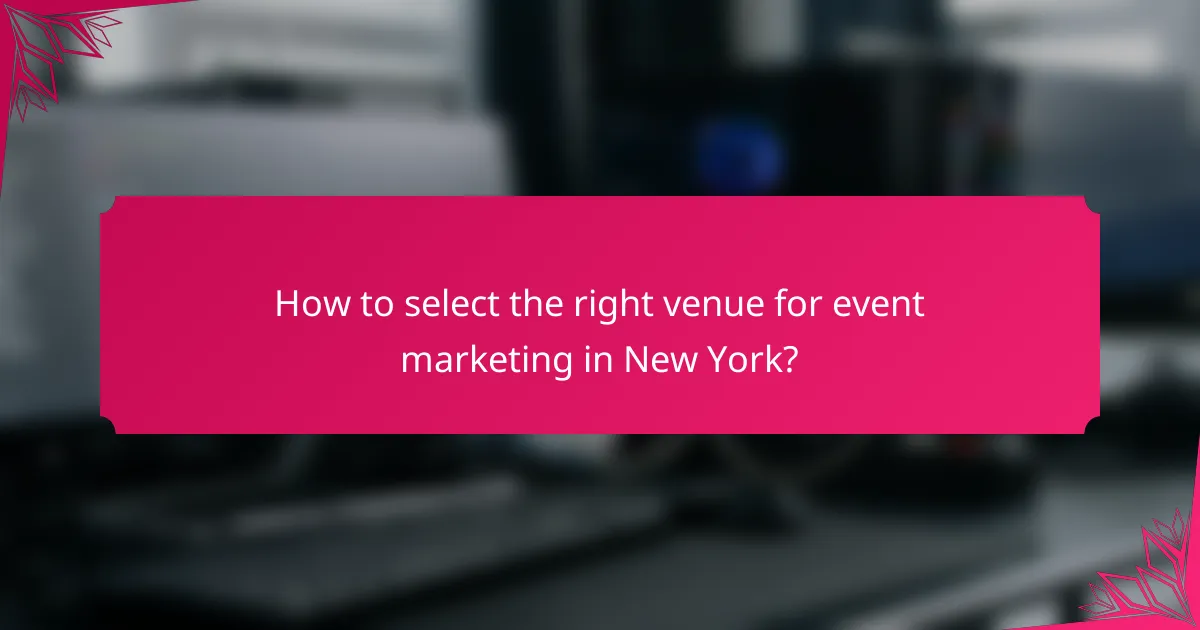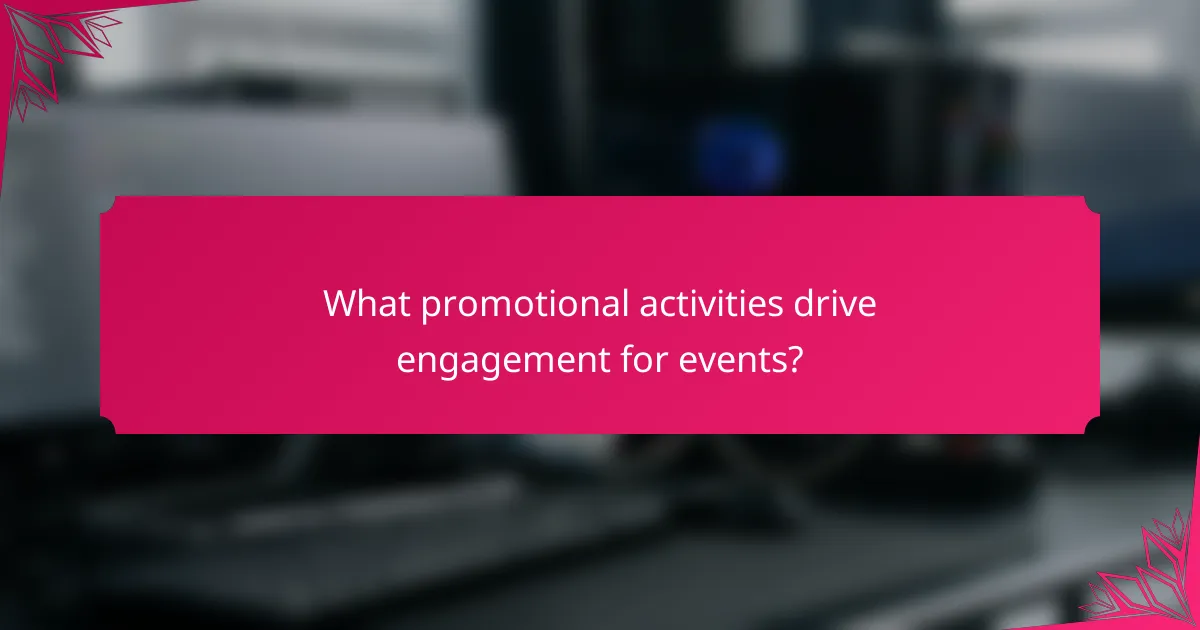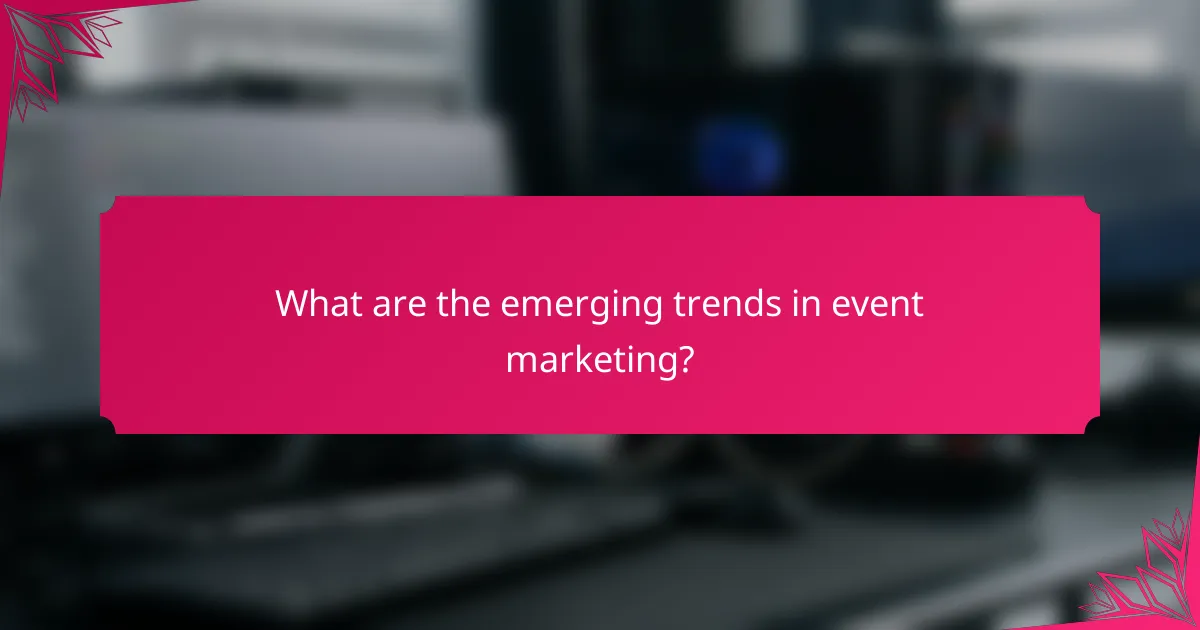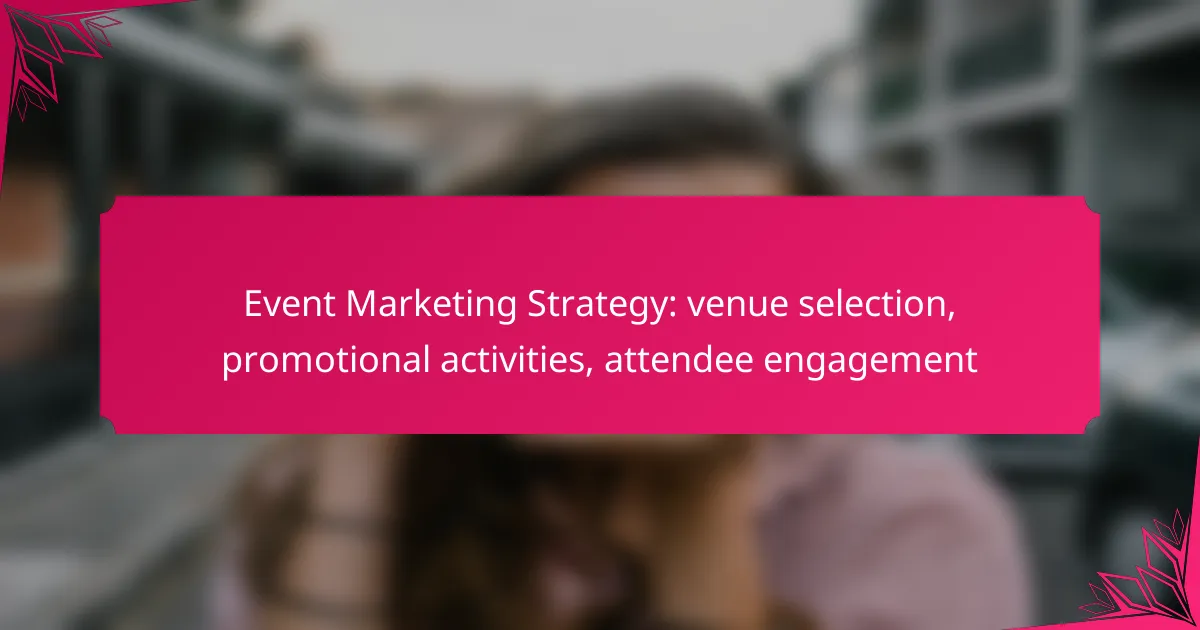Developing a successful event marketing strategy requires careful consideration of venue selection, promotional activities, and attendee engagement. Choosing the right venue can elevate the overall experience, while targeted promotional efforts can boost visibility and excitement. Additionally, fostering engagement through interactive experiences ensures that attendees feel connected and invested in the event.

How to select the right venue for event marketing in New York?
Selecting the right venue for event marketing in New York involves considering factors such as capacity, accessibility, reputation, and budget. A well-chosen venue can significantly enhance attendee experience and engagement, making your event more successful.
Capacity and layout considerations
When choosing a venue, first assess the expected number of attendees. Venues in New York vary widely in capacity, from intimate spaces for a few dozen to large halls accommodating thousands. Ensure the layout supports your event’s activities, whether it’s networking, presentations, or exhibitions.
Consider the flow of the space. A well-designed layout can facilitate interaction among attendees, while a cramped or poorly arranged venue can hinder engagement. Look for venues that offer flexible layouts to adapt to your specific needs.
Accessibility and transportation options
Accessibility is crucial for ensuring all attendees can reach your venue easily. Choose a location with good public transportation links, such as proximity to subway stations or bus routes. Venues near major hubs like Penn Station or Grand Central Terminal are often ideal.
Additionally, consider parking availability and accessibility features for individuals with disabilities. Venues that provide clear directions and have facilities for all attendees can enhance the overall experience and increase attendance.
Venue reputation and past events
The reputation of a venue can influence attendee perception and turnout. Research venues that have hosted similar events successfully, as this can indicate their capability to meet your needs. Look for reviews and testimonials from previous clients to gauge satisfaction levels.
Consider the venue’s brand alignment with your event’s theme. A venue with a strong reputation in your industry can lend credibility to your event and attract more attendees.
Cost and budget alignment
Cost is a significant factor when selecting a venue. Establish a clear budget early on and look for venues that offer packages within that range. In New York, venue costs can vary widely, so be prepared to negotiate and explore different options.
Remember to account for additional expenses such as catering, AV equipment, and service fees. A venue that appears affordable at first glance may have hidden costs that could exceed your budget, so review all terms carefully before making a decision.

What promotional activities drive engagement for events?
Effective promotional activities that drive engagement for events include social media campaigns, email marketing strategies, and influencer partnerships. These methods not only increase visibility but also foster interaction and excitement among potential attendees.
Social media campaigns
Social media campaigns are essential for creating buzz around your event. Platforms like Facebook, Instagram, and Twitter allow you to reach a broad audience quickly and engage them with interactive content such as polls, live videos, and countdowns.
To maximize engagement, consider using targeted ads to reach specific demographics. For instance, if your event is aimed at young professionals, focus your efforts on platforms popular with that group, like Instagram and LinkedIn.
Email marketing strategies
Email marketing remains a powerful tool for event promotion. Crafting personalized messages that highlight event details, speaker line-ups, and early bird discounts can significantly boost attendance rates.
Segment your email list to tailor content for different audience groups. For example, send exclusive offers to previous attendees to encourage repeat participation. Aim for a clear call-to-action to guide recipients toward registration.
Influencer partnerships
Collaborating with influencers can amplify your event’s reach and credibility. Influencers can share their experiences and promote your event to their followers, creating a sense of trust and excitement.
Choose influencers whose audiences align with your target demographic. Provide them with exclusive content or experiences to share, and consider offering them complimentary tickets or VIP access to enhance their engagement with your event.

How to enhance attendee engagement during events?
Enhancing attendee engagement during events involves creating interactive experiences that encourage participation and connection. Key strategies include organizing hands-on sessions, facilitating networking opportunities, and incorporating real-time feedback mechanisms.
Interactive sessions and workshops
Interactive sessions and workshops allow attendees to actively participate rather than passively listen. These formats can include breakout groups, hands-on activities, or skill-building workshops that cater to various interests and expertise levels.
When planning these sessions, consider the size of the group and the available resources. Aim for smaller groups to foster discussion and engagement, typically ranging from 10 to 30 participants. Ensure facilitators are well-prepared to guide discussions and activities effectively.
Networking opportunities
Networking opportunities are crucial for attendee engagement, as they allow participants to connect and share ideas. Structured networking sessions, such as speed networking or themed meetups, can help attendees make valuable connections in a short time.
To maximize networking, create designated areas for informal interactions and provide tools such as attendee directories or mobile apps that facilitate connections. Encourage attendees to share their interests and expertise to spark conversations.
Live polling and Q&A sessions
Live polling and Q&A sessions enhance engagement by allowing attendees to voice their opinions and ask questions in real time. Utilizing technology, such as mobile apps or audience response systems, can make these interactions seamless and dynamic.
Incorporate live polls during presentations to gauge audience sentiment or gather feedback on specific topics. Allocate time for Q&A sessions to address attendee inquiries, ensuring that moderators facilitate discussions effectively while keeping the conversation on track.

What criteria should be considered when choosing a venue?
When selecting a venue, consider factors such as location, capacity, technical capabilities, and amenities. These criteria will significantly impact attendee experience and the overall success of your event.
Location and demographics
The venue’s location is crucial as it affects accessibility for attendees. Choose a site that is convenient for your target audience, ideally near public transportation, hotels, and restaurants. Understanding the demographics of the area can help tailor your event to local preferences.
For example, if your event targets young professionals, a venue in a vibrant urban area may attract more attendees. Conversely, if your audience is more corporate, a location near business districts might be more suitable.
Technical capabilities and amenities
Assess the technical capabilities of the venue, including audio-visual equipment, Wi-Fi availability, and lighting options. Ensure the venue can accommodate your specific needs, such as live streaming or interactive displays, to enhance attendee engagement.
Amenities like catering services, parking facilities, and breakout rooms can also influence your choice. Venues that offer comprehensive packages may save time and reduce stress during planning.

How to measure the success of event marketing strategies?
Measuring the success of event marketing strategies involves evaluating various metrics that reflect attendee satisfaction, engagement, and overall impact. Key indicators include attendee feedback, social media interactions, and lead generation outcomes, which together provide a comprehensive view of an event’s effectiveness.
Attendee feedback and surveys
Collecting attendee feedback through surveys is crucial for understanding their experience and satisfaction levels. Use post-event surveys to gather insights on different aspects such as venue choice, content quality, and networking opportunities. Aim for a response rate of at least 20-30% to ensure the data is representative.
Consider using a mix of quantitative questions (e.g., rating scales) and qualitative open-ended questions to capture detailed opinions. This feedback can guide improvements for future events and help tailor marketing strategies to better meet attendee expectations.
Social media engagement metrics
Social media engagement metrics provide valuable insights into how attendees interacted with your event online. Track likes, shares, comments, and mentions across platforms like Facebook, Twitter, and Instagram to gauge the event’s reach and resonance. A good benchmark is to aim for a 5-10% engagement rate relative to your follower count.
Utilize tools like Google Analytics and social media analytics dashboards to monitor traffic and engagement trends. This data can inform future promotional activities and help refine your messaging for better audience connection.
Lead generation and conversion rates
Lead generation and conversion rates are critical for assessing the financial success of your event marketing strategies. Track the number of leads collected during the event and analyze how many convert into customers or clients afterward. A typical conversion rate for events can range from 10-30%, depending on the industry and target audience.
Implement a clear follow-up strategy post-event to nurture leads effectively. Use email campaigns and personalized outreach to maintain engagement and encourage conversions, ensuring you capitalize on the interest generated during the event.

What are the emerging trends in event marketing?
Emerging trends in event marketing include hybrid event formats, sustainability practices, and personalization through technology. These trends reflect the evolving preferences of attendees and the need for marketers to adapt to changing circumstances.
Hybrid event formats
Hybrid events combine in-person and virtual experiences, allowing broader audience participation. This format caters to those who prefer attending physically and those who opt for online engagement, maximizing reach and flexibility.
When planning hybrid events, consider investing in high-quality streaming technology and interactive tools to enhance the virtual experience. Ensure that both audiences receive equal value, such as live Q&A sessions and networking opportunities.
Sustainability practices
Sustainability in event marketing focuses on minimizing environmental impact through eco-friendly practices. This includes using sustainable materials, reducing waste, and selecting venues that prioritize green initiatives.
To implement sustainability, consider digital ticketing to reduce paper waste, sourcing local food and beverages to lower carbon footprints, and partnering with venues that have strong sustainability certifications. These practices not only appeal to environmentally conscious attendees but can also enhance your brand image.
Personalization through technology
Personalization in event marketing leverages technology to tailor experiences for individual attendees. This can be achieved through data analytics, allowing marketers to understand preferences and behaviors, leading to more relevant content and interactions.
Utilize event apps that allow attendees to customize their schedules and receive personalized recommendations. Additionally, consider using AI-driven tools to analyze attendee data and enhance engagement through targeted messaging and follow-ups.
